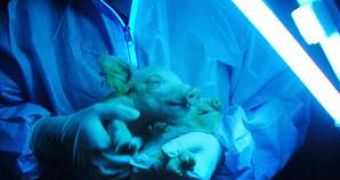Soon, we could make barbecue during nighttime, as the pigs of the future seem to be fluorescent.
The protein named aequorin, from the luminescent jellyfish Aequorea victoria and many other marine organisms, produces a blue glow in the presence of Ca2+ ions, due to a chemical reaction, that's why it has been used to image calcium flow in cells in real time. In December 2006, a team at the Northeast Agricultural University, in Harbin (China), managed to successfully breed partially-green fluorescent pigs in order to boost stem cell research, using the Green Fluorescent Protein (GFP) gene from this jellyfish. The researchers managed to breed three transgenic pigs by injecting the genes of GFP into embryonic pigs.
"The mouth, trotters and tongue of the pigs are green under ultraviolet light. Genetic material from jellyfish was injected into the womb of a sow which gave birth to the three pigs 114 days later in Harbin", said Professor Liu Zhonghua, overseeing the breeding program at Northeast Agricultural University.
China is the fourth country, after US, UK (at Scotland?s Roslin Institute), South Korea and Japan, to succeed this.
But this was not enough. Now, one of the fluorescent pigs has passed on the trait to its young, a hope for future breeding of pigs growing organs for human transplant.
"The glowing piglets? birth proves transgenic pigs are fertile and able to pass on their engineered traits to their offspring", said Liu.
"Continued development of this technology can be applied to ... the production of special pigs for the production of human organs for transplant", Liu posted on the university?s Web site, on Tuesday.
"Two of the 11 piglets glow fluorescent green from their snout, trotters, and tongue under ultraviolet light", reported the team.
"Organs from genetically altered pigs would potentially solve some of the problems of rejected organs in transplant operations. The presence of the green protein will allow genetically modified cells to be tracked if they are transplanted into a human. The fact that the pig?s offspring also appeared to have the green genes would indicate that the genetic modification had successfully penetrated every cell. But much more research and further trials ? both in animals and in humans ? will be necessary before the benefits of the technology could be seen", said Robin Lovell-Badge, a genetics expert at Britain?s National Institute for Medical Research.
In 2007, Tokyo?s Meiji University successfully engineered a pig having the genes for human diabetes.

 14 DAY TRIAL //
14 DAY TRIAL //